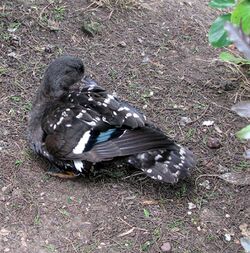Biology:African black duck
| African black duck | |
|---|---|

| |
| Scientific classification | |
| Domain: | Eukaryota |
| Kingdom: | Animalia |
| Phylum: | Chordata |
| Class: | Aves |
| Order: | Anseriformes |
| Family: | Anatidae |
| Genus: | Anas |
| Species: | A. sparsa
|
| Binomial name | |
| Anas sparsa Eyton, 1838
| |
| Subspecies | |
| |
The African black duck (Anas sparsa) is a species of duck of the genus Anas. It is genetically closest to the mallard group,[2] but shows some peculiarities in its behavior[3] and (as far as they can be discerned) plumage; it is accordingly placed in the subgenus Melananas pending further research.
Description
The African black duck is a black duck with pronounced white marks on its back, a dark bill, and orange legs and feet. A purpish-blue speculum is often visible, especially in flight. It lives in central and southern Africa. It is also known as the black river duck, or (A. s. leucostigma) West African black duck or Ethiopian black duck. It is a medium-sized duck, with a length of 48–57 cm (19–22 in). The male is larger than the female.[3]
Distribution
The African black duck is mainly found in eastern and southern sub-Saharan Africa from South Africa north to South Sudan and Ethiopia with outlying populations in western equatorial Africa, in southeast Nigeria, Cameroon and Gabon.[4]
Behavior and reproduction
It is a very shy and territorial duck. It is usually seen in pairs or small flocks. It breeds throughout the year in different areas. Incubation is about 30 days by the mother and the fledgling period is 86 days and only the mother takes care of the young. Their egg quantity ranges from 4 to 8 eggs.[5]
Ecology
Though it likes to stay in rivers and streams during the day it prefers large open waters during the night. This duck likes water in the wooded hills of Africa and hides its nest near running water. Also the African black duck makes its cup shaped nest of driftwood and matted grass. Though it builds its nest near water it is always above flood level and on the ground.[5]
Diet
It is an omnivore that feeds off of larvae and pupae usually found under rocks, aquatic animals, plant material, seeds, small fish, snails, and crabs.[5]
References
- ↑ BirdLife International (2016). "Anas sparsa". IUCN Red List of Threatened Species 2016: e.T22680170A92847774. doi:10.2305/IUCN.UK.2016-3.RLTS.T22680170A92847774.en. https://www.iucnredlist.org/species/22680170/92847774. Retrieved 11 November 2021.
- ↑ Johnson, Kevin P.; Sorenson, Michael D. (1999). "Phylogeny and biogeography of dabbling ducks (genus Anas): a comparison of molecular and morphological evidence". Auk 116 (3): 792–805. doi:10.2307/4089339. http://sora.unm.edu/sites/default/files/journals/auk/v116n03/p0792-p0805.pdf.
- ↑ 3.0 3.1 Johnson, Kevin P.; McKinney, Frank; Wilson, Robert; Sorenson, Michael D. (2000). "The evolution of postcopulatory displays in dabbling ducks (Anatini): a phylogenetic perspective". Animal Behaviour 59 (5): 953–963. doi:10.1006/anbe.1999.1399. PMID 10860522. http://ducksrus.bu.edu/~msoren/pubs/AnimBehav2000b.pdf.
- ↑ "African Black Duck (Anas sparsa)". Handbook of the Birds of the World Alive. Lunx Edicions. http://www.hbw.com/species/african-black-duck-anas-sparsa.
- ↑ 5.0 5.1 5.2 "Anas sparsa (African black duck)". Biodiversity Explorer. Iziko Museums of South Africa. http://www.biodiversityexplorer.org/birds/anatidae/anas_sparsa.htm.
External links
- Photos of the African black duck hosted by the Feather Site.
- Videos of the African black duck hosted by the Internet Bird Collection.
- Species text in The Atlas of Southern African Birds.
Wikidata ☰ Q511979 entry
 |



